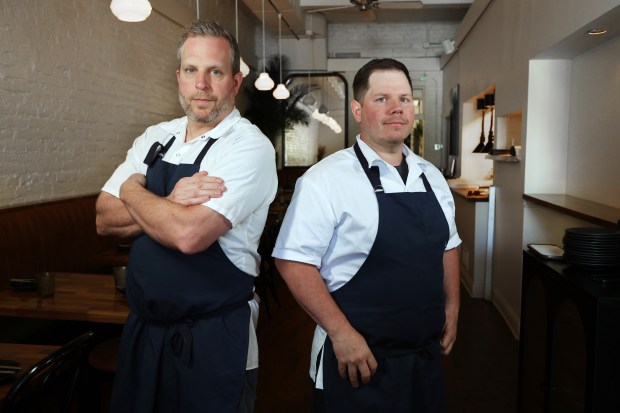John’s Food and Wine has somehow become the revolutionary home to a seemingly new service style, known for how much they pay their employees, deservedly so, but it’s time we talk much more about their beautiful food.
Chefs and co-owners Adam McFarland and Tom Rogers opened their debut restaurant in the Lincoln Park neighborhood of Chicago last fall. It’s named after their fathers. But with all due respect to the dads, their shared name offers no clue to the extraordinary work their sons are doing.
And to be fair, John’s barely has any social media presence, in an era when societies rise and fall online.
The business partners first met in the kitchen at the Asian French restaurant Le Lan in River North under chef Bill Kim, who left to open his pioneering Urbanbelly in 2008. But their defining experience came at Gramercy Tavern, the seasonal American restaurant in New York City, whose original chef was Tom Colicchio, better known to a generation as the head judge on “Top Chef.” There they made as little as $10 an hour.
McFarland describes John’s as a neighborhood restaurant serving New American cuisine.
“And we have taken a different approach to a service style,” he added. “Our labor model is a bit different, but it’s a place where you can see seasonal American cooking by people who are super invested in the community.”
I first went to John’s around St. Patrick’s Day, to try the corned beef sandwich, and see their new school of service too. The sandwich was stunning, unlike any other, a piece of modern art cleaved from tender meat.
The service isn’t that different from other restaurants. There are no reservations, which is not uncommon. You order first, before you’re seated, so that’s a little different at their price point. If you want more drinks or dessert, you can order through a QR code, a newer convenience, which I like. And if you want other food, you can order from one of the many staff members in the dining room, including cooks who also serve. In the end, a 20% service charge that’s effectively a tip goes to hourly employees. And John’s does not accept further gratuities.
That’s all clearly stated on their website and patiently explained in person, while you settle into a vintage Chicago space with hardwood floors, brick walls, an expansive bar in front and an old glass skylight overlooking the dining room in back.
The gorgeous fried fish sandwich is one of the few items that’s remained on the menu by popular demand for good reason, even though the golden panko breaded branzino, piled high with a crisp caper and celery root slaw, breaks a restaurant rule with its kimchi ketchup. That rule says big-brand ketchup is always better than making your own, because we have flavor expectations.
Except at John’s.
They are, in fact, making their own ketchup, but they’re not making any kimchi at all.
“It’s just the spices of kimchi,” McFarland said. The flavor comes through when chile flakes bloom with ginger and sesame, then hits all the right nostalgia notes of both ketchup and kimchi. The house-made condiment brings familiarity and fire to the fried fish, herbed slaw and a signature melted leek aioli, all barely contained in a toasted sesame-seeded bun.
Do note that the sandwich is only available on weekends at lunch.
The cherry glazed ribeye is their highest priced food item, and surprisingly high, compared with the rest of the neighborhood restaurant menu. But the 16-ounce, bone-in, cowgirl cut steak is just part of the story on an impressive plate that begs to be shown off and shared with the table. The lacquered ribeye, topped with a tangle of charred garlic scapes, scattered with gemstones rendered in lardo, rests on a fragrant allium jus. She is the moment. So thoroughly modern, but a bite with all those lovely elements reimagines a bordelaise. The traditional French wine sauce is still offered at steakhouses around the city, including Swift & Sons, where Rogers once worked.
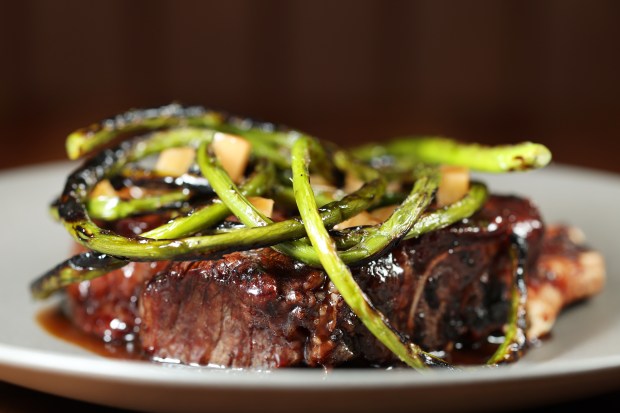
At John’s, they cook their singular steak with a slow brown butter sear at first, he said, then a very low roast, finally finished on a Konro charcoal grill from Japan.
The cherry glaze and allium jus are made with fresh and fermented produce, he added, and the garlic scapes are dressed in nasturtium oil — nasturtium oil! They get the edible flowers and leaves from Nichols Farm for the scallops and use the stems to make a bright and peppery infusion.
The Hokkaido scallops, plump pristine pucks, capture the essence of the deep water sea. They’re beautifully bronzed, served with caramelized romanesco broccoli and softened celtuce, the thick-stemmed Chinese lettuce. A delicately smoked nage, the buttery sauce shimmering with fennel seed oil, is finished with lotus-like nasturtium leaves. The dish is another artful still-life study.
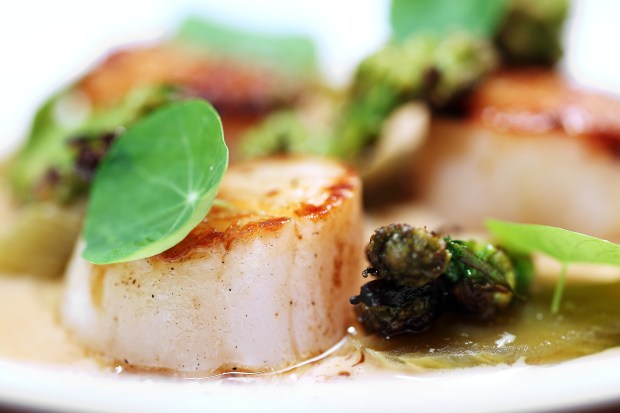
The beef fat fries should be called something else. Even I was skeptical about their $13 price, until I tasted the transcendent crunchy wonders. They began their earthbound lives as prized Kennebec potatoes. But the three-day process (involving blanching, freezing and frying) transforms the tubers into fluffy hearted fries, served with a side of that leek aioli. On weekends at happy hour, you can order them with a martini as their Chicago Happy Meal combo for $20.
The focaccia, a glorious wedge in and of itself, gets gilded with a swipe of silky soft toasted yeast brown butter, which could so easily be mistaken for foie gras mousse that I had to check with the chefs. And I say that as someone who prepared the fatty liver every day in Paris when I cooked at a Michelin-starred restaurant. McFarland said it’s just their seasonal butter, but I’m not sure when the season of toasted yeast brown butter ends, or begins for that matter, so get that focaccia and spread while you can.
We do know it’s tomato and corn season, though. The so-called market salad is really more of a peak pairing with jewel-toned heirloom tomatoes and ripe stone fruit, studded with walnuts, and a radiant gazpacho. The lovely house-made ricotta gnocchi bask in a corn and saffron puree with sautéed Sungold cherry tomatoes, pickled garlic and toasted croutons. The luminous summer tomato salad with whole peeled Sungolds and fat blackberries in ice-cold yuzu buttermilk could serve as a dessert.
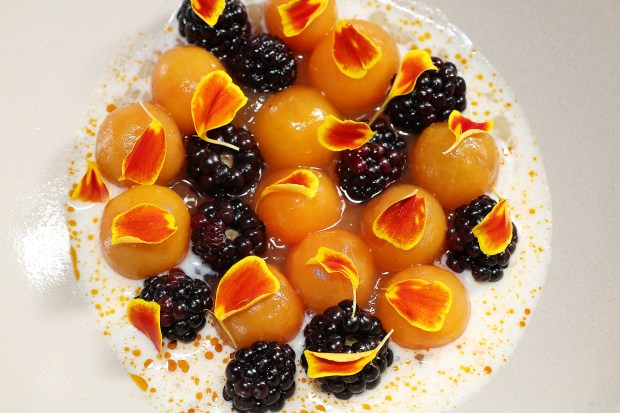
This trio of dishes also disproves the perceived restaurant rule about never repeating ingredients on a menu. Do it! Especially when they demonstrate the many facets of seasonal tomatoes.
The actual desserts, just two, have featured a cloud series by chef Evelyn Aloupas. She previously cooked at the Michelin three-star restaurant Smyth in the West Loop. The current peach cloud consists of an elegant white sesame ice cream with an umami-rich koji peach jam and white chocolate crumble.
The desserts would benefit from more attention, to properly finish the intentional menu that precedes them.
Chef de cuisine Carlos Cruz last cooked at Cultivate by Forbidden Root in Ravenswood.
Together, Aloupas, Cruz, McFarland and Rogers make up the chef team. You’ll see them in the dining room serving dishes. You can also order more food or drinks with any staff member, including general manager and beverage director Jonas Bittencourt, previously at Asador Bastian.
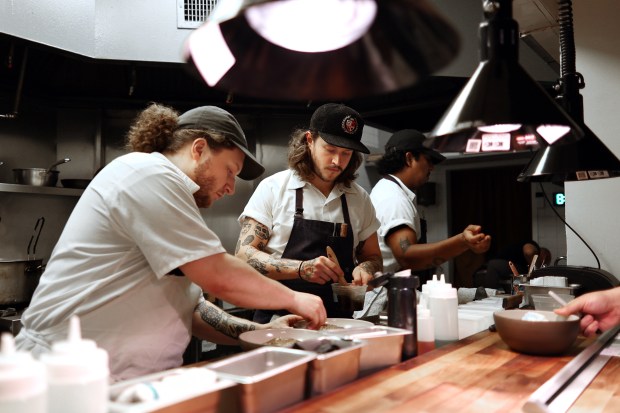
His house whites and house reds are their best-selling wines, Rogers said.
“Jonas is always rotating through the list,” Rogers added. “He shoots for fun, interesting, almost always biodynamically grown, cool, interesting flavors.” They also buy from smaller producers, not a distributor.
The refined Wine Cooler, a lower ABV cocktail with hibiscus and vodka, featured a recent house white, the 2020 Palazzo Tronconi “Arra-iete” Frusinate Bianco, a floral biodynamic Italian wine made with Malvasia grapes.
A refreshing nonalcoholic Dealer’s Choice drink begins with a zesty house-made ginger lemonade, splashed with syrup made from their Seedling Farms excess fruit.
It’s another thoughtful practice at John’s. Where the food is breathtakingly beautiful, and the service friendly and informed. True during lunch at the bar on a quiet Sunday afternoon, and dinner in the back dining room on a loud Friday night. You would never know the people serving your food and drinks aren’t technically servers, if you didn’t have to know about our dysfunctional tipping system.
The tiny entry table where you order and begin your experience desperately needs a more welcoming presence, though, perhaps with some feng shui principles applied. But there’s still time to adapt the space, once home to another restaurant for 40 years.
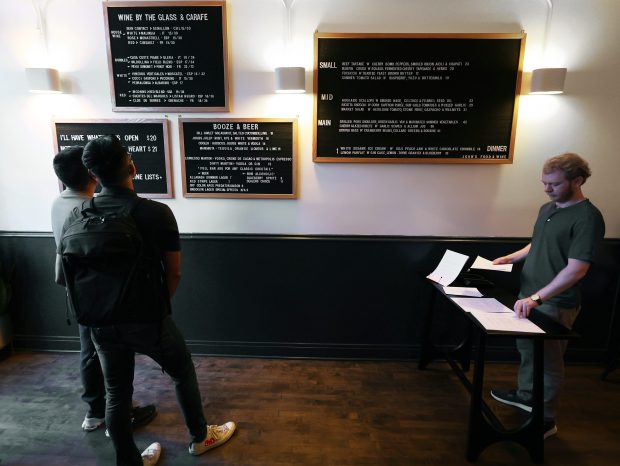
I wondered, had John’s ever had any surcharges?
“Proudly no,” McFarland said. And there’s no option to leave a tip. “That’s something we think just creates a lot of confusion, and sometimes animosity.”
“We’re proud of the cooking that we do and the wine that we serve and the cocktails we make,” he added. “While we do prefer people talking about the care we put into all of our dishes, we don’t mind explaining to people why we have the service model that we do.”
“It’s a small price to pay for being able to take care of our staff the way we do.”
“Tom and I are living our dream right now,” McFarland said. “We’ve never been happier. And we’re happy to have this restaurant that’s so alive and filled with awesome people. And we’re just looking forward to keep going.”
John’s Food and Wine
2114 N. Halsted St.
Open: Daily dinner from 5 p.m., Monday through Thursday to 9:30 p.m., Friday and Saturday to 10 p.m., Sunday to 9 p.m. Weekends lunch from noon to 3:30 p.m., and happy hour from 3:30-5 p.m.
Prices: $12 (focaccia), $19 (summer tomato salad), $33 (Hokkaido scallops), $98 (cherry glazed ribeye), $14 (Wine Cooler), $17 (fried fish sandwich)
Noise: OK when empty (60 to 65 dB), loud when full (80 to 85 dB)
Accessibility: Wheelchair accessible with restrooms on single level
Tribune rating: Outstanding to excellent, 3.5 of 4 stars
Ratings key: Four stars, outstanding; three stars, excellent; two stars, very good; one star, good; no stars, unsatisfactory. Meals are paid for by the Tribune.
Big screen or home stream, takeout or dine-in, Tribune writers are here to steer you toward your next great experience. Sign up for your free weekly Eat. Watch. Do. newsletter here.


